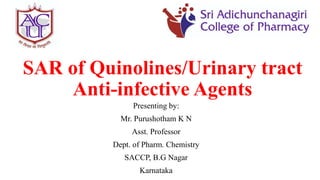SAR of Quinolines.pptx
- 1. SAR of Quinolines/Urinary tract Anti-infective Agents Presenting by: Mr. Purushotham K N Asst. Professor Dept. of Pharm. Chemistry SACCP, B.G Nagar Karnataka
- 2. Quinolones Structure Activity Relationship(SAR);The quinoline antibacterial comprises a group of synthetic substances possessing a common N-1-alkylated-3-carboxy-4- one ring fused to another aromatic ring. Urinary tract Anti-infective Agents
- 3. The general structural requirements for antibacterial activity can be summarized as follows. • 1,4-Dihydro-4-oxo-pyridin-3-carboxylic acid moiety is essential for antibacterial activity. • The pyridone system must be annulated with an aromatic ring.
- 4. • Replacement of nitrogen for carbon at position 2, 5, 6 and 8 are consistent with retention of antibacterial activity. Introduction of substituents at position 2 greatly reduces the activity.
- 5. • Presence of 4-oxo group is must for activity.
- 6. • Fluorine atom substitution at position 6 is associated with significantly enhanced antibacterial activity. • Alkyl substitution at position 1 is essential for activity. Lower alkyl group (methyl, ethyl, cyclopropyl) compounds are having greater potency.
- 7. • Aryl substitution at position 1 is also having consistent activity. • Amino substitution at position 5 gives active compound.
- 8. • Piperazine, N-methyl piperazine and pyrrolidine ring substitution at position 7 gives active compounds. • Chlorine substitution at position 6 results in an active compound.








